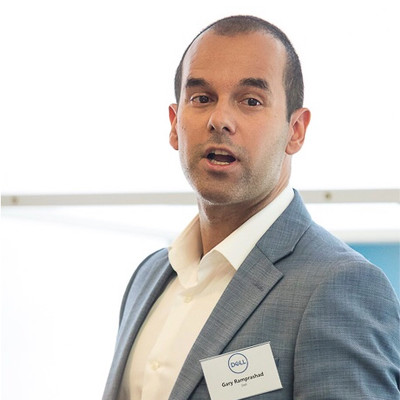Work smarter not harder in 2020
Moving towards multi-device connectivity

Technology is disrupting the ways in which we work today, providing people with the freedom to create and innovate in ways that work for them. We know from the recent findings of Dell Technologies research into the next era of human-machine partnerships, Realizing 2030, that embracing this tide of change can enable us to rid the workplace of age-old inefficiencies and inequities when it comes to using desktop PCs and peripherals.
Gary Ramprashad, Field Marketing Manager, Dell.
The steps we take today, including modernizing IT infrastructure, supporting our employees and deploying the latest software and hardware, will lay the groundwork for the digital future, but success won’t come over night. IDC predicts that digital transformation spending will grow to more than 53% of all ICT investment by 2023, yet for businesses to benefit, it’s crucial they get realistic, and take actionable steps to future-proof their workforce.
You should be sweating it over the little things
Key to modernizing the workforce is remembering that micro changes are as valuable as macro ones. Rome wasn’t built in a day, and the most significant scientific studies of our times were as much a result of detail and discipline as they were big-picture thinking.
Many of us work with computers every day and know all too well that small tasks can have a big impact on our productivity and ultimately, our successes. For example, whilst computer mice and keyboards may remain on the periphery, they have the power to make incremental changes to employees’ productivity on a daily basis. This is one of the reasons we continue to innovate our mouse and keyboard offering at Dell Technologies, in tandem with introducing game-changing 5G enabled products.
Technology help
Similarly, something as simple as having shortcut buttons, allowing users to move back and forth quickly through web pages can free up extra time. These small nuances occur every single day. Built up, they can be the difference between employees feeling burnt out or motivated, which we all know is the making or breaking of a business.
One key example of this is the introduction of dual screens. Wide adoption didn’t happen overnight, yet today, the days of managing numerous business applications and tools from a single screen are numbered. Multitasking has been made easier, avoiding time spent switching back and forth to view, edit and compare important documents and allowing people more space, so they can take in the full picture.
The benefits are even more obvious when we consider the worlds of finance or design. For traders, we know that time is money and high-quality monitors provide them with a clear view of fast-moving market activity. With more space to view numbers, that’s one more way to ensure they do not miss critical trading opportunities. In graphic design, detail is everything when creating imagery and prototypes for their clients, so the ability to quickly move from a brief document to the work in progress itself can save valuable time when working to a tight deadline.
Are you a pro? Subscribe to our newsletter
Sign up to the TechRadar Pro newsletter to get all the top news, opinion, features and guidance your business needs to succeed!
As multiple screens become the norm, we too are becoming accustomed to multitasking as a way of working. This means our computers are under more pressure than ever to perform as we seamlessly navigate from one application to another. If you’ve ever competed with a colleague for the prize of most tabs open at any given time, it’s not necessarily an accolade you want to win. That’s because all actions have a reaction, and the more tabs you’re opening, the more lag you risk experiencing.
Benefitting from the power of three
Using multiple connected PCs at one time could be the solution we’ve all been waiting for, but is yet to realize its full potential.
By connecting up to three PCs such as your desktop, laptop and 2-in-1, users no longer need to sacrifice speed when working from multiple documents. The issue of tab fatigue becomes obsolete with the power of three machines working in the background. In order to benefit from the power of three however, employees must also be equipped with supporting devices that can work seamlessly across 3 PCs at any given time.
For those familiar with Vincent Van Gogh, you may have heard of the saying ‘great things are done by a series of small things brought together’. As we enter a new decade promising rapid technological advancement, it’s important we recognize the small day-to-day changes we can often take for granted, yet have the power to yield great results.
Investing in your people means investing in machines
We’ve all experienced the frustration that’s induced when our computer fails to keep up with our needs, and the reality is that we’re demanding more than ever; both professionally and personally.
Whether it’s juggling time spent with family, friends and partners, with pursuing our hobbies in our personal lives, or managing various work streams and demands in the office, we are constantly balancing responsibilities. Any ways we can find that help simplify our routines are therefore crucial to both our well-being and overall productivity. Whilst employers in the past may have praised those that clock in the extra hours, research from Stanford University reveals that productivity per hour quickly declines when a person works more than 50 hours a week. As our attitudes surrounding what it means to graft and be productive change, so should our technology.
Employers have a responsibility to streamline processes and equip their employees with tools that make their day-to-day that little bit easier. By investing in the right infrastructure, software and hardware, businesses are really investing in their people.
I’d encourage every leader to take notice of the small wins, as well as the larger game-changing ones and empower their colleagues to work smarter, not harder as we enter this exciting new decade.
- We've featured the best alternatives to Microsoft Office.
Gary Ramprashad is the Field Marketing Manager at Dell.
His Specialties includes Pan-European Product Management, Product Development, Introduction & Marketing, Pan-European Buying/Range Management, Supplier Management and Negotiation, Far East Sourcing/Product Development and Supply & Demand Planning
